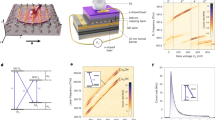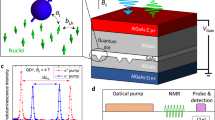Abstract
Qubits, the quantum mechanical bits required for quantum computing, must retain their quantum states for times long enough to allow the information contained in them to be processed. In many types of electron-spin qubits, the primary source of information loss is decoherence due to the interaction with nuclear spins of the host lattice. For electrons in gate-defined GaAs quantum dots, spin-echo measurements have revealed coherence times of about 1 μs at magnetic fields below 100 mT (refs 1, 2). Here, we show that coherence in such devices can survive much longer, and provide a detailed understanding of the measured nuclear-spin-induced decoherence. At fields above a few hundred millitesla, the coherence time measured using a single-pulse spin echo is 30 μs. At lower fields, the echo first collapses, but then revives at times determined by the relative Larmor precession of different nuclear species. This behaviour was recently predicted3,4, and can, as we show, be quantitatively accounted for by a semiclassical model for the dynamics of electron and nuclear spins. Using a multiple-pulse Carr–Purcell–Meiboom–Gillecho sequence, the decoherence time can be extended to more than 200 μs, an improvement by two orders of magnitude compared with previous measurements1,2,5.
This is a preview of subscription content, access via your institution
Access options
Subscribe to this journal
Receive 12 print issues and online access
$259.00 per year
only $21.58 per issue
Buy this article
- Purchase on SpringerLink
- Instant access to full article PDF
Prices may be subject to local taxes which are calculated during checkout



Similar content being viewed by others
References
Petta, J. R. et al. Coherent manipulation of coupled electron spins in semiconductor quantum dots. Science 309, 2180–2184 (2005).
Koppens, F. H. L., Nowack, K. C. & Vandersypen, L. M. K. Spin echo of a single spin in a quantum dot. Phys. Rev. Lett. 100, 236802 (2008).
Cywinski, L., Witzel, W. M. & Das Sarma, S. Pure quantum dephasing of a solid-state electron spin qubit in a large nuclear spin bath coupled by long-range hyperfine mediated interactions. Phys. Rev. B 79, 245314 (2009).
Cywinski, L., Witzel, W. M. & Das Sarma, S. Electron spin dephasing due to hyperfine interactions with a nuclear spin bath. Phys. Rev. Lett. 102, 057601 (2009).
Greilich, A. et al. Mode locking of electrons spin coherence in singly charged quantum dots. Science 313, 341–345 (2006).
Press, D., Ladd, T., Zhang, B. & Yamamoto, Y. Complete quantum control of a single quantum dot spin using ultrafast optical pulses. Nature 456, 218–221 (2008).
Koppens, F. H. L. et al. Control and detection of singlet–triplet mixing in a random nuclear field. Science 309, 1346–1350 (2005).
Foletti, S., Bluhm, H., Mahalu, D., Umansky, V. & Yacoby, A. Universal quantum control in two-electron spin quantum bits using dynamic nuclear polarization. Nature Phys. 5, 903–908 (2009).
Nowack, K. C., Koppens, F. H. L., Nazarov, Y. V. & Vandersypen, L. M. K. Coherent control of a single electron spin with electric fields. Science 318, 1430–1433 (2007).
Barthel, C., Reilly, D. J., Marcus, C. M., Hanson, M. P. & Gossard, A. C. Rapid single-shot measurement of a singlet–triplet qubit. Phys. Rev. Lett. 103, 160503 (2009).
Coish, W. A., Fischer, J. & Loss, D. Exponential decay in a spin bath. Phys. Rev. B 77, 125329 (2008).
Chen, G., Bergman, D. L. & Balents, L. Semiclassical dynamics and long-time asymptotics of the central-spin problem in a quantum dot. Phys. Rev. B 76, 045312 (2007).
Yao, W., Liu, R. B. & Sham, L. J. Theory of electron spin decoherence by interacting nuclear spins in a quantum dot. Phys. Rev. B 74, 195301 (2006).
Childress, L. et al. Coherent dynamics of coupled electron and nuclear spin qubits in diamond. Science 314, 281–285 (2006).
Witzel, W. M. & Das Sarma, S. Quantum theory for electron spin decoherence induced by nuclear spin dynamics in semiconductor quantum computer architecture. Phys. Rev. B 74, 035322 (2006).
Witzel, W. M. & Das Sarma, S. Multiple-pulse coherence enhancement of solid state spin qubits. Phys. Rev. Lett. 98, 077601 (2007).
Lee, B., Witzel, W. M. & Das Sarma, S. Universal pulse sequence to minimize spin dephasing in the central spin decoherence problem. Phys. Rev. Lett. 100, 160505 (2008).
Meiboom, S. & Gill, D. Modified spin-echo method for measuring nuclear relaxation times. Rev. Sci. Instrum. 29, 688–691 (1958).
Khodjasteh, K. & Lidar, D. A. Performance of deterministic dynamical decoupling schemes: Concatenated and periodic pulse sequences. Phys. Rev. A 75, 062310 (2007).
Uhrig, G. S. Keeping a quantum bit alive by optimizing π-pulse sequences. Phys. Rev. Lett. 98, 100504 (2007).
Biercuk, M. J. et al. Optimized dynamical decoupling in a model quantum memory. Nature 458, 996–1000 (2009).
Du, J. et al. Preserving electron spin coherence in solids by optimal dynamical decoupling. Nature 461, 1265–1268 (2009).
Levy, J. Universal quantum computation with spin-1/2 pairs and Heisenberg exchange. Phys. Rev. Lett. 89, 147902 (2002).
Field, M. et al. Measurements of Coulomb blockade with a noninvasive voltage probe. Phys. Rev. Lett. 70, 1311–1314 (1993).
Sundfors, R. K. Exchange and quadrupole broadening of nuclear acoustic resonance line shapes in the III–V semiconductors. Phys. Rev. 185, 458–472 (1969).
Taylor, J. M. et al. Relaxation, dephasing, and quantum control of electron spins in double quantum dots. Phys. Rev. B 76, 035315 (2007).
Hester, R. K., Sher, A., Soest, J. F. & Weisz, G. Nuclear-magnetic-resonance detection of charge defects in gallium arsenide. Phys. Rev. B 10, 4262–4273 (1974).
Bluhm, H., Foletti, S., Mahalu, D., Umansky, V. & Yacoby, A. Enhancing the coherence of a spin qubit by operating it as a feedback loop that controls its nuclear spin bath. Phys. Rev. Lett. 105, 216803 (2010).
Viola, L., Lloyd, S. & Knill, E. Universal control of decoupled quantum systems. Phys. Rev. Lett. 83, 4888–4891 (1999).
Khodjasteh, K. & Viola, L. Dynamically error-corrected gates for universal quantum computation. Phys. Rev. Lett. 102, 080501 (2009).
Acknowledgements
We thank D. J. Reilly for advice on implementing the radiofrequency readout system and J. R. Maze for discussions. We acknowledge financial support from ARO/IARPA, the Department of Defense and the National Science Foundation under award number 0653336. I.N. and M.R. were supported by NSF grant DMR-0906475. This work was carried out in part at the Center for Nanoscale Systems (CNS), a member of the National Nanotechnology Infrastructure Network (NNIN), which is supported by the National Science Foundation under NSF award no. ECS-0335765.
Author information
Authors and Affiliations
Contributions
Electron-beam lithography and molecular-beam-epitaxy growth were carried out by D.M. and V.U., respectively. H.B., S.F. and A.Y. fabricated the sample, planned and executed the experiment and analysed the data. I.N., M.R., H.B. and A.Y. developed the theoretical model. H.B., S.F., I.N., M.R. and A.Y. wrote the paper.
Corresponding author
Ethics declarations
Competing interests
The authors declare no competing financial interests.
Supplementary information
Supplementary Information
Supplementary Information (PDF 474 kb)
Rights and permissions
About this article
Cite this article
Bluhm, H., Foletti, S., Neder, I. et al. Dephasing time of GaAs electron-spin qubits coupled to a nuclear bath exceeding 200 μs. Nature Phys 7, 109–113 (2011). https://doi.org/10.1038/nphys1856
Received:
Accepted:
Published:
Issue date:
DOI: https://doi.org/10.1038/nphys1856
This article is cited by
-
Coherence protection of spin qubits in hexagonal boron nitride
Nature Communications (2023)
-
Ideal refocusing of an optically active spin qubit under strong hyperfine interactions
Nature Nanotechnology (2023)
-
Coupling and readout of semiconductor quantum dots with a superconducting microwave resonator
Science China Physics, Mechanics & Astronomy (2023)
-
Predicting solid state material platforms for quantum technologies
npj Computational Materials (2022)
-
Quantum-to-classical transition in a spin star network
Pramana (2022)



